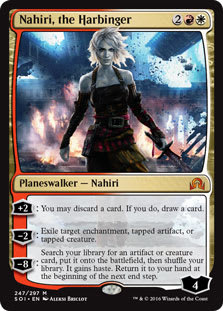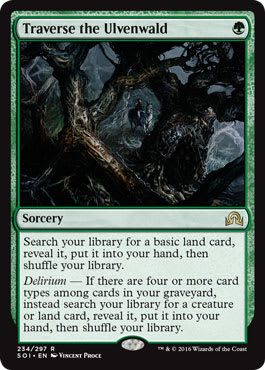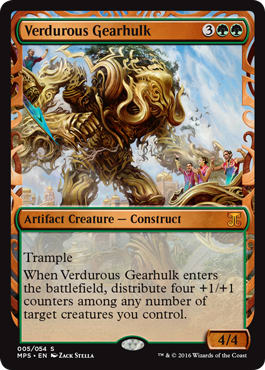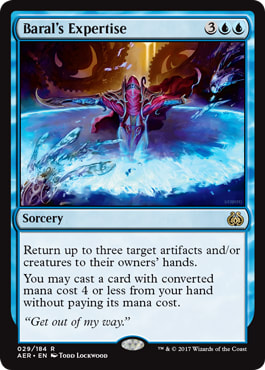Well, I hope that makes the double-dip of Four-Color Saheeli league recordings worth it! I know that many of you are sick and tired of Mardu this and Copycat that, but I assure you, the tweaks and adjustments possible within the 2.5 major archetypes of the format almost make up for the lack of ostensible deck diversity. Beyond that, a narrow format made for the opportunity to do this, which makes it all worthwhile, right?

We Tried!
Okay, in all seriousness, where to begin? Well, it started about two weeks ago, when my East-West Bowl compatriot Alex Majlaton won his RPTQ with Four-Color Saheeli just as I was getting kicked around in Indianapolis in Modern. Now, many of you do not have the pleasure of hearing from Alex as often as I do, but that man is prone to hyperbole from time to time. (Excessive use of hyperbole is endemic among Magic players in general, but Alex takes it to the point of ironic self-deprecating parody, which makes it all the more amusing.) “I think Saheeli is disgustingly good”, coming from Alex, meant that he probably went 5-0 in a MTGO League with the deck after coming home from his RPTQ win, but even so, I was inclined to give the deck a shot. I put a review like that at slightly more positive than “I think this might be the worst deck that I have ever played, and I’ve played with Bogles in Modern.” Of course, Brad Nelson’s article about his unbelievable win percentage with the deck online helped push me to tinker with it more, with a starting point that struck me as streamlined and powerful, yet open to just about any innovative inclusion I could imagine. In short, it was the perfect Standard deck for me to take into the lab for an extended brew session.
I started here:
Four-Color Saheeli ? Aether Revolt Standard | Ben Friedman
- Creatures (16)
- 4 Felidar Guardian
- 4 Rogue Refiner
- 4 Servant of the Conduit
- 4 Whirler Virtuoso
- Planeswalkers (8)
- 1 Tamiyo, Field Researcher
- 3 Chandra, Torch of Defiance
- 4 Saheeli Rai
- Instants (4)
- 4 Harnessed Lightning
- Sorceries (4)
- 4 Attune with Aether
- Enchantments (7)
- 3 Oath of Chandra
- 4 Oath of Nissa
- Lands (21)
- 1 Island
- 1 Mountain
- 1 Plains
- 5 Forest
- 1 Evolving Wilds
- 2 Game Trail
- 2 Spirebluff Canal
- 4 Aether Hub
- 4 Botanical Sanctum
- Sideboard (15)
- 2 Tireless Tracker
- 2 Authority of the Consuls
- 1 Dispel
- 2 Natural State
- 3 Negate
- 1 Tamiyo, Field Researcher
- 2 Baral's Expertise
- 2 Release the Gremlins
The very first thing I noticed was that Whirler Virtuoso was super redundant in multiples, and I might be able to open up a slot in the deck by shaving a single copy of that card. I also noticed that no one online seemed to play around Shock anymore, which made that card’s stock rise dramatically for me. Nahiri, the Harbinger struck me as potentially impressive, especially in the mirror match, where it could kill an opposing Authority of the Consuls, combat mana flood, or exile an errant Tireless Tracker or Servant of the Conduit. At the same time, Oath of Chandra seemed a little bit worse than I’d hoped, as there was little ![]()
![]() Constrictor and a lot of Mardu Vehicles online. Shock is a major key to keeping up on tempo against Toolcraft Exemplar starts, while being a great surprise play to break up an opposing Saheeli Rai combo turn. I loved being able to hold up one mana rather than two and stay safe from the death by one thousand Cats, but more problems emerged with the deck as I rounded the fifty-match mark.
Constrictor and a lot of Mardu Vehicles online. Shock is a major key to keeping up on tempo against Toolcraft Exemplar starts, while being a great surprise play to break up an opposing Saheeli Rai combo turn. I loved being able to hold up one mana rather than two and stay safe from the death by one thousand Cats, but more problems emerged with the deck as I rounded the fifty-match mark.
First of all, I kept getting mana flooded. Like, almost every game that I didn’t lose to a Mardu rush involved me getting mana flooded to some degree. It sounds crazy, considering the deck runs only 21 lands, but I got so sick and tired of losing to drawing a Botanical Sanctum or an Attune with Aether in the midgame that I decided to do something I’d never done before in my history of competitive play. I started cutting lands from a stock decklist, and a consensus “best deck” at that. Heresy, I know. I would have laughed at myself, too. But twenty lands with an extra Planeswalker wasn’t too bad. I still rarely got manascrewed, and I still frequently got manaflooded. What did I do? I got a little bit more aggressive, cutting another land and turning the deck into a lean, mean, Heart of Kiran-toting machine. I was tired of getting bashed by opposing Hearts of Kiran from Mardu Vehicles, so I figured that maybe the best way to protect my Planeswalkers and pressure my opponents’ was to include three copies of the legendary artifact myself! It did a stellar job of protecting my Chandras, my Tamiyos, and my Saheelis. This deck, maybe more than Mardu Vehicles, benefitted immensely from the cheap evasive threat, especially because Vigilance and the Loyalty crew ability combined so well when playing both sides of the ball. I started to get pretty into my Heart of Kiran build with 19 lands and a super low curve, and I thought that I was pretty darn smart for figuring out an angle in the mirror. I loved how a Heart of Kiran on the draw both kept my opponent from being able to play a Saheeli Rai while simultaneously protecting mine from Rogue Refiner and Servant of the Conduit alike. Two Shocks over two lands, and three copies of Heart of Kiran over two Oath of Chandra and a Whirler Virtuoso, and I thought I had it all figured out. To be fair, I still think that that list was a major upgrade over the traditional Saheeli deck, but I wasn’t done tinkering yet. No, not by a long shot.
The first inkling of a change came when I set up a four-loyalty Saheeli Rai with Heart of Kiran protection against Mardu Ballista, and my opponent used a timely Unlicensed Disintegration for maximum punishment. If it had just been a regular creature, I would have likely won that game. The second inkling of a major change came when I was streaming with the deck, and a viewer commented that I was simply playing what amounted to a Kaladesh Limited deck, replete with a grand total of zero mana sinks. This, while I was in the middle of getting flooded and complaining about how it shouldn’t be possible to get flooded with a nineteen land deck. Then, it came up in one of my team chats from none other than the inimitable Tommy Ashton that Brazilian MTGO grinder Batutinha was tinkering with a version of the deck that included a number of Essence Flux as a maindeckable Dispel to protect the combo against Mardu Vehicles. While Essence Flux failed to prove its worth over a number of matches, there was a single Walking Ballista in the sideboard of this Brazilian RPTQ-derived deck. Joao Claudio Souza had a piece of the puzzle lurking inconspicuously in his sideboard, while the ostentatious trick in the maindeck turned out to be red herring! The final piece of the puzzle was seeing the ubiquity of Walking Ballista in the formerly hyper-aggressive Mardu decks, and deciding that Ballista might be the best prophylactic measure against getting comboed in the mirror. While both Ballista and Heart of Kiran help combat early combo threats from the mirror match, only Walking Ballista acts as creature removal, Planeswalker pressure, and a great mana sink while simultaneously keeping our Oath of Nissa hit density high. (You may laugh at this last one, but I’ve seen enough Oath of Nissa bricks in my testing to care deeply about my hit percentage with that card!) Three Ballistas made their way into the maindeck, and they dramatically increased my number of outs to seemingly insurmountable board positions.
The wonderful thing about Ballista in Saheeli is that it increases your removal density while acting as your sole mana sink in a notoriously mana-heavy deck, both of which are critically important here. Forget Mardu Ballista, Four-Color Ballista is where it’s at! To be sure, I was ready to bring a few Ballistas to battle in New Jersey, and I thought that I had a significant deck edge over the traditionalists (who were sure to continue playing the stock list after Lukas Blohon’s finals appearance at the MOCS). Turns out, we had only begun to see how deep the rabbit hole went.
MisplacedGinger is a big MTGO grinder with a ton of trophies with Four-Color Saheeli, and their lists in the days leading up to the Grand Prix had a couple of Walking Ballistas main as well. Though I still hadn’t gotten a single 5-0 with the deck myself, it felt validating to know that others who were having some success with the deck were experimenting with the same changes as me. More than just Walking Ballista, though, MisplacedGinger cut two copies of Attune with Aether to include a similar, but slightly more powerful spell in Traverse the Ulvenwald. To be honest, I’m ashamed that I didn’t think of it first. Traverse solves so many problems for this deck, it’s not even funny. Not only does Walking Ballista fuel Delirium, but Traverse finds Felidar Guardian, a late copy of Ballista, or even a spicy 5-drop like Verdurous Gearhulk or Ishkanah, Grafwidow. Talk about combatting mana flood! How many games would I have won if my late game draw of Attune with Aether instead been a Traverse the Ulvenwald? The only question that remained was, how few lands could I reasonably play in order to play a large number of one-mana Lay of the Land effects? I won’t lie, until the wee hours of the morning before the tournament, I was rocking a Legacy-esque eighteen land special, but I decided that it was extremely important to have a turn-one Green mana source, and I didn’t want to mulligan a ton of hands with two land searchers but no Green source, so I cut an Attune with Aether for a second Evolving Wilds at the last minute. In retrospect, that decision might be wrong, but I wanted to be a little bit more cautious. The fact that the extra Evolving Wilds fuels Delirium a bit better for the midgame Traverses pushed me over the edge, and I don’t regret the decision.
This brings me to the only major rule of Four-Color Saheeli going forward. You want no more than nineteen lands. Fill in the gaps with extra copies of Traverse the Ulvenwald (which should never go below three copies, of course!) or Attune with Aether. With nineteen lands and five Lay of the Lands, you’re already at a virtual 24 lands plus your four Servant of the Conduit. Tack on the Oath of Nissa (which hit a land half the time anyway!) and you’re talking about a deck that’s half mana. Kind of non-intuitive, considering the deck only has nineteen actual lands, but that’s the secret that people couldn’t seem to wrap their heads around before. Everything in your deck design should serve the greater purpose of improving consistency, and here that means preventing mana flood. Play more Traverses and fewer actual lands. Your win percentage will thank you for it.
As for 5-drops, there are two serious choices, and then there are those players who want to play Skysovereign, Consul Flagship. Ishkanah, Grafwidow and Verdurous Gearhulk are both so synergistic with the rest of the deck, while being top-notch ways of either gumming up a board or breaking through and opponent’s board, whichever you need. Traverse the Ulvenwald finds both of them, and they’re both powerful cards that don’t require any help to win games. Skysovereign was dead a bit too often for my taste, but the Green mythic rares both impressed in their own ways. Though I got scared and cut the maindeck Verdurous Gearhulk for a maindeck Tireless Tracker, I would instantly switch back to a Gearhulk if I could run back the tournament this weekend. Tracker is great at snowballing for wins if it sticks around, but I’m not willing to sacrifice access to either of the Green mythics, and the Tracker is the easiest cut.
The tournament itself was a blur of mirror matches and Mardu matches, broken up by a few lone holdouts in ![]()
![]() Emerge, Jiachen Tao’s Aetherworks Marvel deck, and a
Emerge, Jiachen Tao’s Aetherworks Marvel deck, and a ![]()
![]() Midrange deck. I was lucky to fade certain death in a number of those matches, and with a string of great luck came my deepest run at a Grand Prix yet. Although I couldn’t find a White mana source in time in Game 3 of the finals, I’m still ecstatic. The extra Pro Points would have locked me for Gold, but a single 12-3 finish at an upcoming Grand Prix will lock that up just the same, so I guess I still have something to fight for!
Midrange deck. I was lucky to fade certain death in a number of those matches, and with a string of great luck came my deepest run at a Grand Prix yet. Although I couldn’t find a White mana source in time in Game 3 of the finals, I’m still ecstatic. The extra Pro Points would have locked me for Gold, but a single 12-3 finish at an upcoming Grand Prix will lock that up just the same, so I guess I still have something to fight for!
Unfortunately for those of you who came looking for a sideboard guide, there really isn’t one. I was changing it up match-to-match, bringing in different numbers of Negate or Metallic Rebuke or Baral's Expertise against Mardu depending on play/draw and the specific hate cards I saw, while cutting as low as two of each combo piece against the mirror and boarding into a midrange Bristling Hydra deck. Things change depending on the opponent’s plan, and you can’t prepare in a meaningful way outside of sculpting a board plan that works for you and your playstyle. The same logic applies to the specific list you choose. While I do think that a Delirium/Ballista build of the deck is better than the Elder Deep-Fiend build or the Aetherworks Marvel build, you have a ton of options depending on your metagame. Lots of ![]()
![]() Snake? Board a third Baral's Expertise. Mardu opponents beating you up with Archangel Avacyn too much? Board in a Clip Wings or change your counterspell suite up to two Metallic Rebukes and board those in against Mardu. Do you like Release the Gremlins more than Natural State or Natural Obsolescence? Great! Switch it up. I went with the cards that played more fluidly for me, but there is always room to tinker. And therein lies the silver lining of the dark cloud that is this Standard format. You may not like the diversity among archetypes, but there is a ton going on within each of the major players, and the games themselves are as intricate as any Caw-Blade or Delver mirror I’ve ever played. That said, if you just want to give yourself the best chance to win, I do heartily advocate for a build close to what I played at the GP. Just for reference:
Snake? Board a third Baral's Expertise. Mardu opponents beating you up with Archangel Avacyn too much? Board in a Clip Wings or change your counterspell suite up to two Metallic Rebukes and board those in against Mardu. Do you like Release the Gremlins more than Natural State or Natural Obsolescence? Great! Switch it up. I went with the cards that played more fluidly for me, but there is always room to tinker. And therein lies the silver lining of the dark cloud that is this Standard format. You may not like the diversity among archetypes, but there is a ton going on within each of the major players, and the games themselves are as intricate as any Caw-Blade or Delver mirror I’ve ever played. That said, if you just want to give yourself the best chance to win, I do heartily advocate for a build close to what I played at the GP. Just for reference:
Four-Color Saheeli ? Aether Revolt Standard | Ben Friedman
- Creatures (19)
- 1 Ishkanah, Grafwidow
- 1 Tireless Tracker
- 3 Rogue Refiner
- 3 Walking Ballista
- 3 Whirler Virtuoso
- 4 Felidar Guardian
- 4 Servant of the Conduit
- Planeswalkers (6)
- 2 Chandra, Torch of Defiance
- 4 Saheeli Rai
- Instants (5)
- 1 Shock
- 4 Harnessed Lightning
- Sorceries (5)
- 2 Attune with Aether
- 3 Traverse the Ulvenwald
- Enchantments (6)
- 2 Oath of Chandra
- 4 Oath of Nissa
- Lands (19)
- 1 Island
- 1 Mountain
- 1 Plains
- 4 Forest
- 2 Evolving Wilds
- 2 Game Trail
- 4 Aether Hub
- 4 Botanical Sanctum
- Sideboard (15)
- 2 Bristling Hydra
- 1 Tireless Tracker
- 2 Authority of the Consuls
- 1 Dispel
- 1 Metallic Rebuke
- 1 Natural Obsolescence
- 2 Natural State
- 2 Negate
- 1 Nahiri, the Harbinger
- 2 Baral's Expertise
The deck is infinitely customizable. It has access to all five colors, so if you want to throw a Sorin, Grim Nemesis in there, who am I to say no? Never before have we gotten a Splinter Twin-style deck so flexible that it could play a six-mana off-color Planeswalker, but with this version of Four-Color Saheeli, the world is your oyster. Just don’t get too carried away with the fun of the deck and forget to actually combo-kill your opponent when the coast is clear! And if that isn’t your cup of tea, you could do worse than play the Mardu menace yourself. It truly is a disturbingly powerful deck in its own right, but there are definitely ways to beat it. No, I don’t think this metagame is done quite yet, not by a long shot.
As for me, I’ll be in Las Vegas by the time this article hits, so we’ll just have to see if I can combine Aces and Kings like so many Cat Beasts and Planeswalkers. Plus, the cowboy hat goes over almost as well at the poker table as it does in the Twitch chat whenever I’m in a video feature match. Wish me luck!
Ben “40card” Friedman
@40cardfriedman on Twitter





























